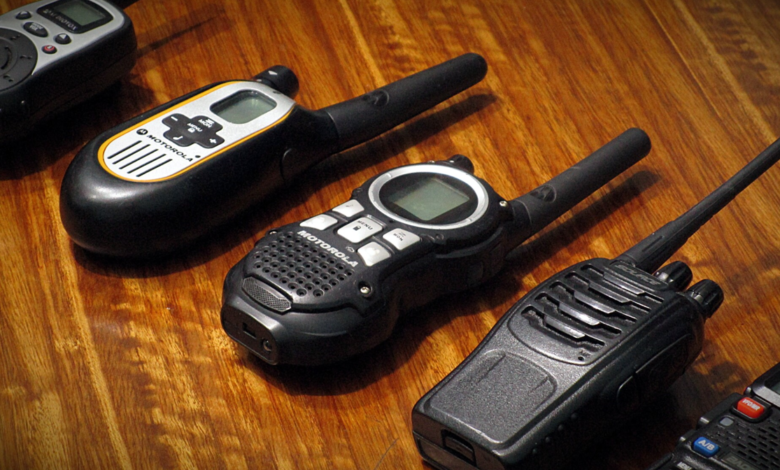The Ultimate Guide to the Different Types of Two-Way Radios

When the radio was conceptualized in the late 1890s, it was intended to transmit simple messages in Morse code. However, it evolved to play music and allow people to communicate effectively with one another.
While many modern radios are merely tools to listen to music or broadcasts, there are plenty of two-way radios available that allow users to send and receive voice messages.
If you’re unsure what the types of two-way radios are, you’ll want to continue reading to learn the history behind each kind and what the pros and cons are.
Table of Contents
Different Modes of Two-Way Radios
Before you can look into the different types of Two-way radios, you’ll need to understand the modes in which you can use a radio. There are three different modes, so understanding which kind you want will influence the type of two-way you invest in.
Stationary, often referred to as base radios, are located in a residence or commercial building like an emergency service building. These are plugged into an outlet and usually have an extended range. You can also install an antenna to extend the capacity and add the wattage to the device.
However, there are also portable options available. These are most commonly found in trucks, police cars, taxis, and other first responder vehicles. These can reach a large area, but not as far as base radios.
Finally, there are handheld two-way radios. More commonly known as walkie-talkies, the handheld is a great option for those nearby looking to communicate with each other. They are easy to operate and small enough to carry around without obstruction.
You’ll need to consider what mode of radio communication would work best for your needs and what type of radio is most accessible for you.
Ham
One of the most common types of two-way radio is known as ham radio. These are used for non-commercial forms of communication and are popular among hobbyists and technology fiends.
However, to use and operate a ham radio, a person must be licensed, as per the Federal Communications Commission. To obtain these licenses, you’ll need to take an exam to show, which can take a significant amount of time.
This is because all kinds of ham radios have a long-range which can interfere with other frequencies. There are specific frequencies that you can access depending on your license.
Ham radios are ideal for wilderness survivors or those who live in remote areas where cell phone service isn’t always reliable. This is because the ham range is vast, and with so many enthusiasts, you’ll be able to get into contact with someone.
CB
A CB radio is most commonly associated with long-haul truckers, as this is the type of radio most widely found in trucks. This is known as Citizens Band radio because of its ease of use.
With nearly forty channels, this is one of the most minor regulated forms of radio communication. Unlike other radio services, you don’t need a license to operate these. The only rule is that overseas communication is forbidden.
Another perk of these two-way communication devices is their affordability. Many options are under one hundred dollars, meaning you can get a decent radius for cheap.
Another perk of CB radios is that they are a semi-permanent fixture in many vehicles. This means they’re designed to look sleek and stylish to avoid appearing bulky or out of place in your truck.
The radius also depends on the terrain and if there are objects such as mountains or buildings in the way.
However, because no rules or regulations are surrounding this service, it can be filled with vulgarity from users. Those who are sensitive to this may want to avoid choosing a CB radio.
GMRS and FRS
If you’re looking for shorter, clearer transmissions, GMRS radios are perfect for you. This service operates on FM, which has the better quality for sending and receiving communications.
However, you will need a license to operate a GRMS device. Luckily, if you plan on getting two-way radio options for your whole family, you only need one license per family.
This option is ideal for those who are concerned with safety and communicating with a specific group of people. For example, if you live in a remote area, ensuring each member of your family within a twenty-five-mile radius has a GRMS radio will suffice.
However, if you don’t want to pay for a license at all, you can opt for FRS radios. These share channels with GMRS, meaning they function at a similar frequency.
FRS radios cover a much smaller radius and are commonly comprised of hand-held communication devices. For example, those who are camping in groups could benefit from this signal as it’s more concentrated in a smaller area.
If you’re exploring your walkie-talkie options, you’ll want to look at a Rocky Talkie review to help you determine which option is best for your needs.
Invest in the Best Two-Way Radios
Whether you’re looking for a new hobby, want to prioritize safety, or are interested in technology, two-way radios have so many benefits. Knowing which option works best for your needs is crucial, as you don’t want to get a radio that requires a license to operate.
If you found this guide to the best two-way radios for your needs informative, you’ll want to visit the rest of our website. There you’ll find more helpful technology tips, tricks, and information to make your communications simple.


